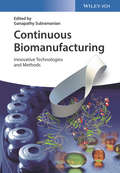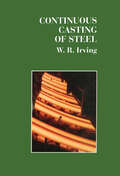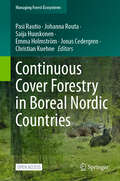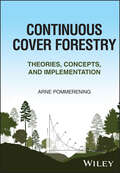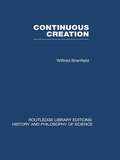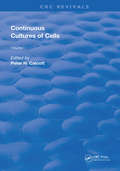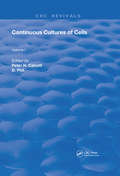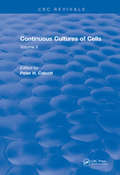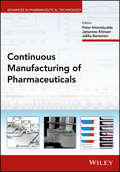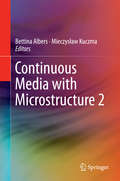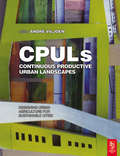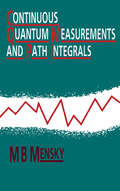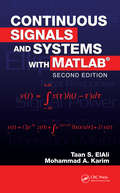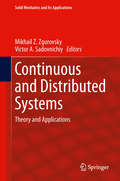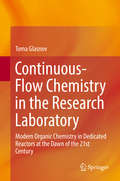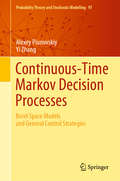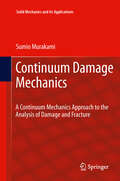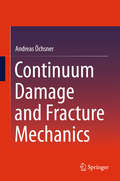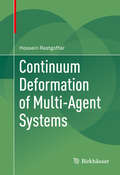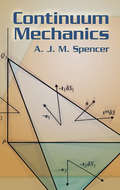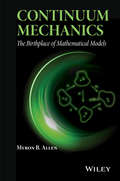- Table View
- List View
Continuous Biomanufacturing: Innovative Technologies and Methods
by Ganapathy SubramanianThis is the most comprehensive treatise of this topic available, providing invaluable information on the technological and economic benefits to be gained from implementing continuous processes in the biopharmaceutical industry. Top experts from industry and academia cover the latest technical developments in the field, describing the use of single-use technologies alongside perfusion production platforms and downstream operations. Special emphasis is given to process control and monitoring, including such topics as 'quality by design' and automation. The book is supplemented by case studies that highlight the enormous potential of continuous manufacturing for biopharmaceutical production facilities.
Continuous Biopharmaceutical Processes: Chromatography, Bioconjugation, and Protein Stability (Cambridge Series in Chemical Engineering)
by David Pfister Lucrèce Nicoud Massimo MorbidelliThis innovative reference provides a coherent and critical view on the potential benefits of a transition from batch to continuous processes in the biopharmaceutical industry, with the main focus on chromatography. It also covers the key topics of protein stability and protein conjugation, addressing the chemical reaction and purification aspects together with their integration. This book offers a fine balance between theoretical modelling and illustrative case studies, between fundamental concepts and applied examples from the academic and industrial literature. Scientists interested in the design of biopharmaceutical processes will find useful practical methodologies, in particular for single-column and multi-column chromatographic processes.
Continuous Casting of Steel
by W.R. IrvingThis monograph on the continuous casting of steel has been produced at the request of the Institute of Materials with the aim of providing university professionals and students, those already working in the steel industry and steel plant suppliers in related activities, with a concise account of the engineering, process and product technology of the continuous casting of steel and how this has been developed over recent years. is one of the series of monographs published by the Institute and particularly compliments a similar publication on the casting of aluminium. It covers the historical development of the process and the supply of liquid steel to the machine and describes in detail the various components of the main types of machines for the casting of billets, blooms and slabs respectively.
Continuous Cover Forestry in Boreal Nordic Countries (Managing Forest Ecosystems #45)
by Pasi Rautio Johanna Routa Saija Huuskonen Emma Holmström Jonas Cedergren Christian KuehneThis open access book compiles the latest research on continuous cover forestry in boreal forests, highlighting both the need for additional information and the exciting possibilities that this method presents. Experts in the field explore topics such as forest regeneration, genetic effects, wood production and yield, wood harvesting, forest damage agents, biodiversity, water effects, carbon cycles of forests, economics, forest planning methods, multiple uses of forests, and forest owners' attitudes. As the world faces increasing pressure to balance the multiple goals of forest management, including raw material production, carbon sequestration, biodiversity, and climate change adaptation, it is becoming clear that different forest management methods are required. Even-aged forest management is well-researched, but continuous forest management is a newer and rapidly evolving approach that is gaining popularity in boreal forests. While an overall synthesis of the subject is not yet possible, this book provides an essential foundation for understanding the current state of continuous cover forestry in boreal forests. With the new research data being accumulated all the time, this book is an invaluable resource for researchers, policymakers, and forest managers who want to stay up-to-date on this important topic.
Continuous Cover Forestry: Theories, Concepts, and Implementation
by Arne PommereningCONTINUOUS COVER FORESTRY Gain expertise in the development of healthier, more sustainable forests with this indispensable guide Continuous Cover Forestry (CCF) is an approach to forest management with over a century of history, one which applies ecological principles to the project of developing biologically diverse, structurally complex forests. Long used as the standard forest management method in Central Europe, CCF is generating renewed interest globally for its potential to develop and sustain forests that can withstand climate change impacts, maintain forest biodiversity in the face of major ecological challenges and offer better recreation experience. There is an increasingly urgent need for forest scientists and policymakers to be familiar with the toolkit provided by CCF. Continuous Cover Forestry: Theories, Concepts, and Implementation provides a thorough, up-to-date introduction to the theory and practice of CCF. Beginning with an overview of the method’s history and its foundational principles, the book provides detailed guidance for applying CCF methods to a range of ecological scenarios and forest types. The result is a clear, comprehensive portrait of this increasingly effective set of forestry tools. Continuous Cover Forestry readers will also find: Case studies throughout showing CCF at work in real-world forests Detailed discussion of topics such as forest structure, transformation, silvicultural systems, training, carbon forestry, conservation and more R code ready to take and apply Simple, adaptable models for deriving quantitative guidelines for CCF woodlands Continuous Cover Forestry is ideal for students, scholars and practitioners of forest science, forest ecology, conservation, and environmental management, as well as policymakers dealing with forestry or climate policy.
Continuous Creation: A Biological Concept of the Nature of Matter (Routledge Library Editions: History & Philosophy of Science)
by Wilfred BranfieldOriginally published in 1950, this book challenged the basis of our beliefs about the relation of life to matter. Already aware that chalk, limestone and coal seams are the residues of ancient life, the author suggests that this knowledge may also be applied to the rest of matter. In that case, he argues, the origin of the world was not cosmic upheaval which broke down at last into life, but organic life itself.
Continuous Cultures Of Cells (Routledge Revivals #1)
by Pete H. CalcottFirst Published in 1981, this book offers a full insight into the development of cell cultures. Carefully compiled and filled with a vast repertoire of notes, diagrams, and references this book serves as a useful reference for students of microbiology and other practitioners in their respective fields.
Continuous Cultures Of Cells: Volume I (Crc Press Revivals Ser.)
by Pete H. CalcottThis book aims to present as broad a perspective as possible to the subject matter. In the construction of the chapters, much has been left to the individual contributors. Some chapters have been written essentially up to the minute reviews of an application or use of continuous culture whilst other have used data obtained in the author‘s own laboratory to illustrate the use of continuous culture as a problem-solving tool. Yet others have concentrated on specific topics and cited a few key ways in which continuous culture can be useful. The approach was left solely up to the contributor.
Continuous Cultures of Cells: Volume II (CRC Press Revivals)
by Peter H. CalcottThis two-volume set will be useful to the established continuous culture operator, as well as the researcher, teacher, and student who is interested in learning how the technique of continuous culture could be useful in answering both basic and applied questions in microbiology and cell biology.
Continuous Manufacturing of Pharmaceuticals
by Johannes Khinast Jukka Rantanen Peter KleinebuddeA comprehensive look at existing technologies and processes for continuous manufacturing of pharmaceuticals As rising costs outpace new drug development, the pharmaceutical industry has come under intense pressure to improve the efficiency of its manufacturing processes. Continuous process manufacturing provides a proven solution. Among its many benefits are: minimized waste, energy consumption, and raw material use; the accelerated introduction of new drugs; the use of smaller production facilities with lower building and capital costs; the ability to monitor drug quality on a continuous basis; and enhanced process reliability and flexibility. Continuous Manufacturing of Pharmaceuticals prepares professionals to take advantage of that exciting new approach to improving drug manufacturing efficiency. This book covers key aspects of the continuous manufacturing of pharmaceuticals. The first part provides an overview of key chemical engineering principles and the current regulatory environment. The second covers existing technologies for manufacturing both small-molecule-based products and protein/peptide products. The following section is devoted to process analytical tools for continuously operating manufacturing environments. The final two sections treat the integration of several individual parts of processing into fully operating continuous process systems and summarize state-of-art approaches for innovative new manufacturing principles. Brings together the essential know-how for anyone working in drug manufacturing, as well as chemical, food, and pharmaceutical scientists working on continuous processing Covers chemical engineering principles, regulatory aspects, primary and secondary manufacturing, process analytical technology and quality-by-design Contains contributions from researchers in leading pharmaceutical companies, the FDA, and academic institutions Offers an extremely well-informed look at the most promising future approaches to continuous manufacturing of innovative pharmaceutical products Timely, comprehensive, and authoritative, Continuous Manufacturing of Pharmaceuticals is an important professional resource for researchers in industry and academe working in the fields of pharmaceuticals development and manufacturing.
Continuous Media with Microstructure 2
by Bettina Albers Mieczysław KuczmaThis book presents research advancesin the field of Continuous Media with Microstructure and considers the threecomplementary pillars of mechanical sciences: theory, research andcomputational simulation. It focuses on the followingproblems: thermodynamic and mathematical modeling of materials withextensions of classical constitutive laws, single and multicomponent mediaincluding modern multifunctional materials, wave propagation, multiscale andmultiphysics processes, phase transformations, and porous, granular andcomposite materials. The book presents the proceedings ofthe 2nd Conference on Continuous Media with Microstructure, which was held in2015 in Å agów, Poland, in memory of Prof. Krzysztof WilmaÅ,,ski.
Continuous Productive Urban Landscapes: Designing Urban Agriculture For Sustainable Cities
by Joe Howe Katrin Bohn Andre ViljoenThis book on urban design extends and develops the widely accepted 'compact city' solution. It provides a design proposal for a new kind of sustainable urban landscape: Urban Agriculture. By growing food within an urban rather than exclusively rural environment, urban agriculture would reduce the need for industrialized production, packaging and transportation of foodstuffs to the city dwelling consumers. The revolutionary and innovative concepts put forth in this book have potential to shape the future of our cities quality of life within them. Urban design is shown in practice through international case studies and the arguments presented are supported by quantified economic, environmental and social justifications.
Continuous Quantum Measurements and Path Integrals
by M.B MenskyAdvances in technology are taking the accuracy of macroscopic as well as microscopic measurements close to the quantum limit, for example, in the attempts to detect gravitational waves. Interest in continuous quantum measurements has therefore grown considerably in recent years. Continuous Quantum Measurements and Path Integrals examines these measurements using Feynman path integrals. The path integral theory is developed to provide formulae for concrete physical effects. The main conclusion drawn from the theory is that an uncertainty principle exists for processes, in addition to the familiar one for states. This implies that a continuous measurement has an optimal accuracy-a balance between inefficient error and large quantum fluctuations (quantum noise). A well-known expert in the field, the author concentrates on the physical and conceptual side of the subject rather than the mathematical.
Continuous Signals and Systems with MATLAB (Electrical Engineering Textbook Series)
by Mohammad A. Karim Taan S. ElAliDesigned for a one-semester undergraduate course in continuous linear systems, Continuous Signals and Systems with MATLAB, Second Edition presents the tools required to design, analyze, and simulate dynamic systems. It thoroughly describes the process of the linearization of nonlinear systems, using MATLAB to solve most examples and problems. With updates and revisions throughout, this edition focuses more on state-space methods, block diagrams, and complete analog filter design.
Continuous and Distributed Systems: Theory and Applications (Solid Mechanics and Its Applications #211)
by Mikhail Z. Zgurovsky Victor A. SadovnichiyIn this volume, the authors close the gap between abstract mathematical approaches, such as abstract algebra, number theory, nonlinear functional analysis, partial differential equations, methods of nonlinear and multi-valued analysis, on the one hand, and practical applications in nonlinear mechanics, decision making theory and control theory on the other. Readers will also benefit from the presentation of modern mathematical modeling methods for the numerical solution of complicated engineering problems in hydromechanics, geophysics and mechanics of continua. This compilation will be of interest to mathematicians and engineers working at the interface of these field. It presents selected works of the open seminar series of Lomonosov Moscow State University and the National Technical University of Ukraine "Kyiv Polytechnic Institute". The authors come from Germany, Italy, Spain, Russia, Ukraine, and the USA.
Continuous-Flow Chemistry in the Research Laboratory: Modern Organic Chemistry in Dedicated Reactors at the Dawn of the 21st Century
by Toma GlasnovThis book presents a short introduction to the historical background to the field, the state of the art and a brief survey of the available instrumentation and the processing techniques used. The following major areas of interest in synthetic, organic and medicinal chemistry are elaborated on: transition-metal catalyzed reactions, organocatalytic transformations, heterocyclic synthesis, and photochemical reactions. Finally, selected applications in industry are also discussed. With its ample presentation of examples from recent literature, this is an essential and reliable source of information for both experienced researchers and postgraduate newcomers to the field.
Continuous-Time Markov Decision Processes: Borel Space Models and General Control Strategies (Probability Theory and Stochastic Modelling #97)
by Yi Zhang Alexey PiunovskiyThis book offers a systematic and rigorous treatment of continuous-time Markov decision processes, covering both theory and possible applications to queueing systems, epidemiology, finance, and other fields. Unlike most books on the subject, much attention is paid to problems with functional constraints and the realizability of strategies.Three major methods of investigations are presented, based on dynamic programming, linear programming, and reduction to discrete-time problems. Although the main focus is on models with total (discounted or undiscounted) cost criteria, models with average cost criteria and with impulsive controls are also discussed in depth.The book is self-contained. A separate chapter is devoted to Markov pure jump processes and the appendices collect the requisite background on real analysis and applied probability. All the statements in the main text are proved in detail.Researchers and graduate students in applied probability, operational research, statistics and engineering will find this monograph interesting, useful and valuable.
Continuous-Time Markov Jump Linear Systems (Probability and Its Applications)
by Oswaldo Luiz Costa Marcelo D. Fragoso Marcos G. TodorovIt has been widely recognized nowadays the importance of introducing mathematical models that take into account possible sudden changes in the dynamical behavior of a high-integrity systems or a safety-critical system. Such systems can be found in aircraft control, nuclear power stations, robotic manipulator systems, integrated communication networks and large-scale flexible structures for space stations, and are inherently vulnerable to abrupt changes in their structures caused by component or interconnection failures. In this regard, a particularly interesting class of models is the so-called Markov jump linear systems (MJLS), which have been used in numerous applications including robotics, economics and wireless communication. Combining probability and operator theory, the present volume provides a unified and rigorous treatment of recent results in control theory of continuous-time MJLS. This unique approach is of great interest to experts working in the field of linear systems with Markovian jump parameters or in stochastic control. The volume focuses on one of the few cases of stochastic control problems with an actual explicit solution and offers material well-suited to coursework, introducing students to an interesting and active research area. The book is addressed to researchers working in control and signal processing engineering. Prerequisites include a solid background in classical linear control theory, basic familiarity with continuous-time Markov chains and probability theory, and some elementary knowledge of operator theory.
Continuum Damage Mechanics: A Continuum Mechanics Approach to the Analysis of Damage and Fracture (Solid Mechanics and Its Applications #185)
by Sumio MurakamiRecent developments in engineering and technology have brought about serious and enlarged demands for reliability, safety and economy in wide range of fields such as aeronautics, nuclear engineering, civil and structural engineering, automotive and production industry. This, in turn, has caused more interest in continuum damage mechanics and its engineering applications. This book aims to give a concise overview of the current state of damage mechanics, and then to show the fascinating possibility of this promising branch of mechanics, and to provide researchers, engineers and graduate students with an intelligible and self-contained textbook. The book consists of two parts and an appendix. Part I is concerned with the foundation of continuum damage mechanics. Basic concepts of material damage and the mechanical representation of damage state of various kinds are described in Chapters 1 and 2. In Chapters 3-5, irreversible thermodynamics, thermodynamic constitutive theory and its application to the modeling of the constitutive and the evolution equations of damaged materials are descried as a systematic basis for the subsequent development throughout the book. Part II describes the application of the fundamental theories developed in Part I to typical damage and fracture problems encountered in various fields of the current engineering. Important engineering aspects of elastic-plastic or ductile damage, their damage mechanics modeling and their further refinement are first discussed in Chapter 6. Chapters 7 and 8 are concerned with the modeling of fatigue, creep, creep-fatigue and their engineering application. Damage mechanics modeling of complicated crack closure behavior in elastic-brittle and composite materials are discussed in Chapters 9 and 10. In Chapter 11, applicability of the local approach to fracture by means of damage mechanics and finite element method, and the ensuing mathematical and numerical problems are briefly discussed. A proper understanding of the subject matter requires knowledge of tensor algebra and tensor calculus. At the end of this book, therefore, the foundations of tensor analysis are presented in the Appendix, especially for readers with insufficient mathematical background, but with keen interest in this exciting field of mechanics.
Continuum Damage and Fracture Mechanics
by Andreas ÖchsnerThis textbook offers readers an introduction to fracture mechanics, equipping them to grasp the basic ideas of the presented approaches to modeling in applied mechanics In the first part, the book reviews and expands on the classical theory of elastic and elasto-plastic material behavior. A solid understanding of these two topics is the essential prerequisite to advancing to damage and fracture mechanics. Thus, the second part of this course provides an introduction to the treatment of damage and fractures in the context of applied mechanics Wherever possible, the one-dimensional case is first introduced and then generalized in a following step. This departs somewhat from the more classical approach, where first the most general case is derived and then simplified to special cases. In general, the required mathematics background is kept to a minimum Tutorials are included at the end of each chapter, presenting the major steps for the solution and offering valuable tips and tricks. The supplementary problems featured in the book
Continuum Deformation of Multi-Agent Systems
by Hossein RastgoftarThis monograph presents new algorithms for formation control of multi-agent systems (MAS) based on principles of continuum mechanics. Beginning with an overview of traditional methods, the author then introduces an innovative new approach whereby agents of an MAS are considered as particles in a continuum evolving in ℝn whose desired configuration is required to satisfy an admissible deformation function. The necessary theory and its validation on a mobile-agent-based swarm test bed are considered for two primary tasks: homogeneous transformation of the MAS and deployment of a random distribution of agents on a desired configuration. The framework for this model is based on homogeneous transformations for the evolution of an MAS under no inter-agent communication, local inter-agent communication, and intelligent perception by agents. Different communication protocols for MAS evolution, the robustness of tracking of a desired motion by an MAS evolving in ℝn, and the effect of communication delays in an MAS evolving under consensus algorithms or homogeneous maps are also explored. Featuring appendices which introduce the requisite concepts from continuum kinematics and graph theory, this monograph will provide advanced graduate students and researchers with the necessary background to understand and apply the methods presented.
Continuum Mechanics
by A. J. SpencerThe mechanics of fluids and the mechanics of solids represent the two major areas of physics and applied mathematics that meet in continuum mechanics, a field that forms the foundation of civil and mechanical engineering. This unified approach to the teaching of fluid and solid mechanics focuses on the general mechanical principles that apply to all materials. Students who have familiarized themselves with the basic principles can go on to specialize in any of the different branches of continuum mechanics. This text opens with introductory chapters on matrix algebra, vectors and Cartesian tensors, and an analysis of deformation and stress. Succeeding chapters examine the mathematical statements of the laws of conservation of mass, momentum, and energy as well as the formulation of the mechanical constitutive equations for various classes of fluids and solids. In addition to many worked examples, this volume features a graded selection of problems (with answers, where appropriate). Geared toward undergraduate students of applied mathematics, it will also prove valuable to physicists and engineers. 1992 edition.
Continuum Mechanics
by Franco M. CapaldiThis is a modern textbook for courses in continuum mechanics. It provides both the theoretical framework and the numerical methods required to model the behaviour of continuous materials. This self-contained textbook is tailored for advanced undergraduate or first year graduate students with numerous step-by-step derivations and worked out examples. The author presents both the general continuum theory and the mathematics needed to apply it in practice. The derivation of constitutive models for ideal gases, fluids, solids and biological materials, and the numerical methods required to solve the resulting differential equations, are also detailed. Specifically, the text presents the theory and numerical implementation for the finite difference and the finite element methods in the Matlab® programming language. It includes thirteen detailed Matlab® programs illustrating how constitutive models are used in practice.
Continuum Mechanics
by Myron B. AllenPresents a self-contained introduction to continuum mechanics that illustrates how many of the important partial differential equations of applied mathematics arise from continuum modeling principles Written as an accessible introduction, Continuum Mechanics: The Birthplace of Mathematical Models provides a comprehensive foundation for mathematical models used in fluid mechanics, solid mechanics, and heat transfer. The book features derivations of commonly used differential equations based on the fundamental continuum mechanical concepts encountered in various fields, such as engineering, physics, and geophysics. The book begins with geometric, algebraic, and analytical foundations before introducing topics in kinematics. The book then addresses balance laws, constitutive relations, and constitutive theory. Finally, the book presents an approach to multiconstituent continua based on mixture theory to illustrate how phenomena, such as diffusion and porous-media flow, obey continuum-mechanical principles. Continuum Mechanics: The Birthplace of Mathematical Models features: Direct vector and tensor notation to minimize the reliance on particular coordinate systems when presenting the theory Terminology that is aligned with standard courses in vector calculus and linear algebra The use of Cartesian coordinates in the examples and problems to provide readers with a familiar setting Over 200 exercises and problems with hints and solutions in an appendix Introductions to constitutive theory and multiconstituent continua, which are distinctive for books at this level Continuum Mechanics: The Birthplace of Mathematical Models is an ideal textbook for courses on continuum mechanics for upper-undergraduate mathematics majors and graduate students in applied mathematics, mechanical engineering, civil engineering, physics, and geophysics. The book is also an excellent reference for professional mathematicians, physical scientists, and engineers.
Continuum Mechanics In The Earth Sciences
by William I. NewmanContinuum mechanics underlies many geological and geophysical phenomena, from earthquakes and faults to the fluid dynamics of the Earth. This interdisciplinary book provides geoscientists, physicists and applied mathematicians with a class-tested, accessible overview of continuum mechanics. Starting from thermodynamic principles and geometrical insights, the book surveys solid, fluid and gas dynamics. In later review chapters, it explores new aspects of the field emerging from nonlinearity and dynamical complexity and provides a brief introduction to computational modeling. Simple, yet rigorous, derivations are used to review the essential mathematics. The author emphasizes the full three-dimensional geometries of real-world examples, enabling students to apply this in deconstructing solid earth and planet-related problems. Problem sets and worked examples are provided, making this a practical resource for graduate students in geophysics, planetary physics and geology and a beneficial tool for professional scientists seeking a better understanding of the mathematics and physics within Earth sciences.
